1937 FLOOD
from The Evening Guide Thursday January 14, 1937
With fearful suddenness, the Ganaraska River went on a sweeping rampage here this morning, inundating a large section of the downtown area, flooding scores of cellars, marooning many residents and in some instances death was averted by a mere hair's breadth. The town of Port Hope never saw so much water and even the flood of February last year was eclipsed as well as the one in 1929 which caused thousands of dollars worth of damage. Fortunately, on this occasion, there was an absence of heavy ice, but at that, considerable small ice came down as well as debris such as barrels, logs, boards, etc.
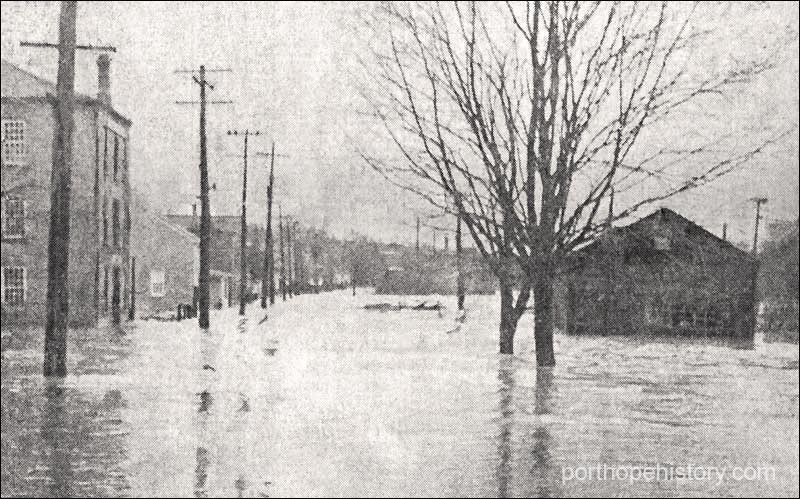
Cavan Street, near South Street Jan 15, 1937
photo by Chris Woods, Toronto Telegram
The inundation crippled practically the entire town. Very little work was done this morning. Factory employees were unable to get to their jobs and many merchants and their clerks were unable to reach their business places. When they did get downtown, many, especially those on Ontario street and the lower part of Walton street, were uable to enter their stores.
School children were unable to get to their respective schools. Communication from one side of the town was severed and many residents used the Canadian Pacific Viaduct to get across town.
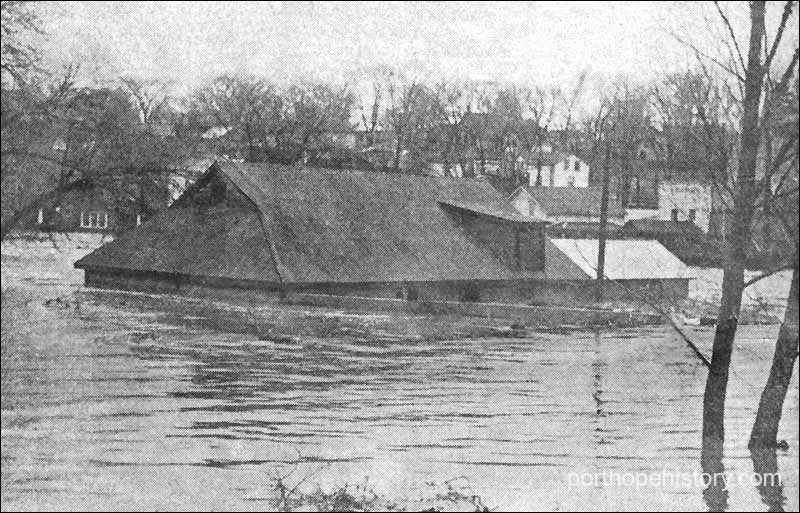
photo by Chris Woods, Toronto Telegram Jan 15, 1937
Then again, motorists used the Dale-Welcome cut-off and came into town from the northerly route. Some of the more adventuresome ones crossed the Peter Street bridge earlier in the morning, but a short time later, even this route was impassable.
In order to get first-hand information, the Guide representative crossed the Peter Street bridge in a light delivery truck about nine o'clock. With the waves pounding against the bridge, the machine lurched sideways in the middle of the structure. The water was from three to four feet high. The engine coughed and sputtered but kept going and the other side was reached in safety.
Once in awhile, other vehicles picked their way across. James Bennett, A&P store manager, managed to get across and the spray surged over the top of the sedan.
Corbett's Dam held back an immense amount of water and it swept down through the unused dam, flooding the area around Ontario College of Art Summer School and marooned the family of William Lowes on the north side of the creek.
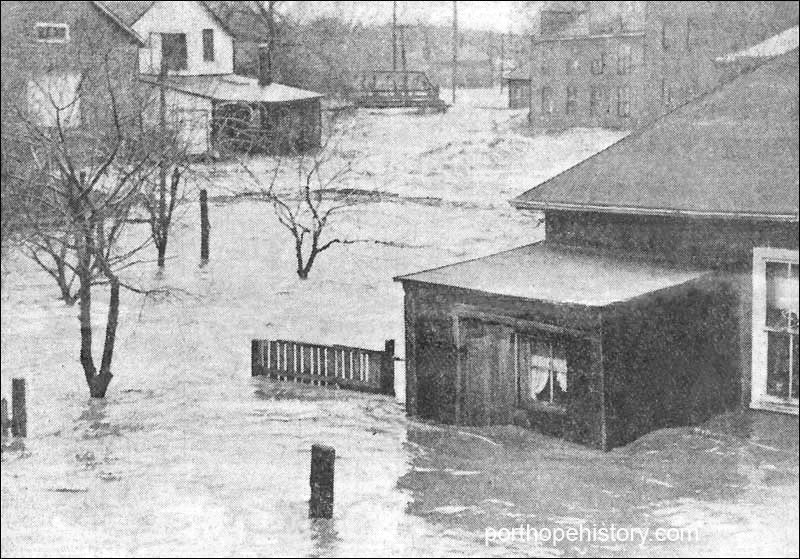
photo by Chris Woods, Toronto Telegram Jan 15, 1937
The muddy turbulent water poured into Beamish's Pond and houses along Cavan street were surrounded by water.
The surging tide then continued through the centre of the town. Spray splashed high against the Ontario Street bridge and water flowed over the new Walton street structure. It took a heavy pounding and the railing on the north side was crumpled. Water ran down Queen and Mill Streets, flooding Rotary Park and the district about the dance pavilion.
Torrential rain started to fall on Wednesday night about eight o'clock and continued well past daylight this morning.
The Ganaraska, fed by its many northern tributaries, did not seriously threaten until about four o'clock this morning. Between five and six o'clock, it was apparent that a severe inundation was on its way. One assisting angle in connection with the trouble was the lack of ice, whereas last year tons of ice swept through the streets causing heavy damage.
The stores on the west side of Ontario sustained severe damage. The owners, anticipating a flood, had removed most of the stock to safety, but the stock in Cancilla's fruit store met with heavy loss.
The stores occupied by Jex & Smith, the Agriculture Department, R S Brown Estate, Chas Cancilla, E Broadbent and Geo T Hancock and the Toronto Bank were flooded and streams of water poured from the doorways.
Driftwood, logs, ice, etc piled up against the Ontario Street bridge and huge cakes of ice were lodged on the Midland Railway tracks. Railway traffic on the Midland Division was completely demobilized and it will be some time before the right of way is cleared.
The brick cottage, occupied by T Roberts on the west side of the tracks was nearly submerged but 'Tom' vacated the premises early in the evening.
The three new brick houses occupied by T Marshall, I Margies and W Roberts on the east side of Ontario Street were surrounded by water and Roberts Bros' butcher shop and the residence in the rear came in for their share of the water.
The maddening waters surged through the lumber yard of T Marshall and quantities of lumber were carried downstream. The sawing outfit at the rear of the property was damaged to a considerable extent. The rise in water proved too much for the retaining wall at the foot of Walton Street and although tons of water were turned down the river course by the wall, the water also surged around the northern end and down Mill Street.
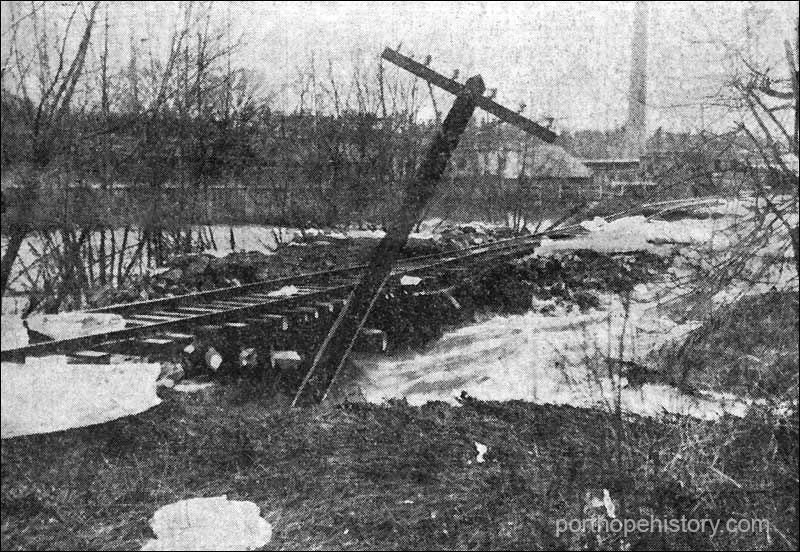
photo by Chris Woods, Toronto Telegram Jan 15, 1937
The dwellings occupied by T Harwood and Miss E Croft were completely surrounded and at one time the angry waters reached the base of Jacob's Ladder. It has been a long time since the water level reached the Registry Office and McMahon's Law Office.
The Brewery Warehouse and the two garages saw a seething mass of water flowing lakewards.
Fred Little's blacksmith's shop was completely undermined and the livery stable and two neighbouring garages were flooded.
Late in the night Mrs Douglas was in that vicinity looking for her husband and left her baby in a carriage on the Ontario street bridge. She waded across Ontario Street and the water carried her up against a wire fence. She was assisted to safety by Ralston Roberts but the small child was in danger on the bridge. John Tozer came to the rescue in time and the youngster was brought to safety.
At midnight, the water began to creep over the Walton Street bridge and about three o'clock had reached such velocity that the stores occupied by T J McMahon, W Yeoman and W Smith were completely washed downstream. The other stores in that vicinity suffered from flooding and all the stores on the north side of Walton Street, east from J L Westaway's came in for a large amount of water.
Early this morning a horse, the property of T Marshall, was drowned in the stable in the mill yard. Another horse was released and swam to safety. Employees were unable to get to work this morning as the downtown arteries were blocked. At 7:20 the first car crossed over the Peter Street Bridge and later, vehicles could pass down Walton Street and also on Ontario Street.
In an effort to assist the flow of water, men attempted to raise the stoplogs at Marshall's Mill on Ontario Street. Town foreman Jack Martyn, Councillor J C McLellan and Robert Robertson, a mill employee, tried to raise the logs at the end of the structure. Suddenly the chain snapped. A heavy log swept sideways and swept the men off their feet. McLellan and Martyn grasped each other, and by sheer luck grabbed a chain. Robertson jumped to a cement abutment and was safe. The two men worked their way to safety while billows of water surged by. John Marshall and Vincent Harwood were at the other end of the dam but jumped to safety. "We had a close shave," Jack Martyn told the Guide. "I thought we were gone, but McLellan and I happened to grab each other. I hit my knee on the cement but managed to hang on and at one time, just the ends of my fingers I grasped the edge."
At 8:50 am the pounding waters carried away a portion of the sidewall of Caldwell's large cement block garage on Ontario Street.
Thomas Roberts, who sustained heavy damage last year, was marooned in his house near the Ontario Street bridge and although the remainder of his family left, the septagenarian, who is just recovering from an illness, refused to leave.
Town foreman Jack Martyn and a half dozen of civic employees were out all night with the town truck. They have been cruising about town rendering assistance wherever possible. At eight o'clock, Councillor McLellan and Lorne Williams, driving the truck, backed through three feet of water on Barrett Street and carried Mr and Mrs Eric Munro to safety.
This summer, the management of the Ontario Hotel erected large concrete walls at the end of their property, but at daylight, water was near the top of the walls. However, they helped to stem the force of the water. The stables, yards, and the hotel proper were flooded and water poured from the main entrances. All the stores along Ontario Street came in for their share of the water and in many instances, merchants were unable to remove their stocks as the cellars were flooded to the floorboards.
Water poured through the Fire Department quarters and as a precautionary measure the pumper was removed from its place and taken to the corner of Walton and John Streets. Officials were hoping that fire would not break out as activities would have been hampered to some degree. At 11 o'clock, the ringing of the fire bells summoned the firemen in order to be on hand in case of emergencies.
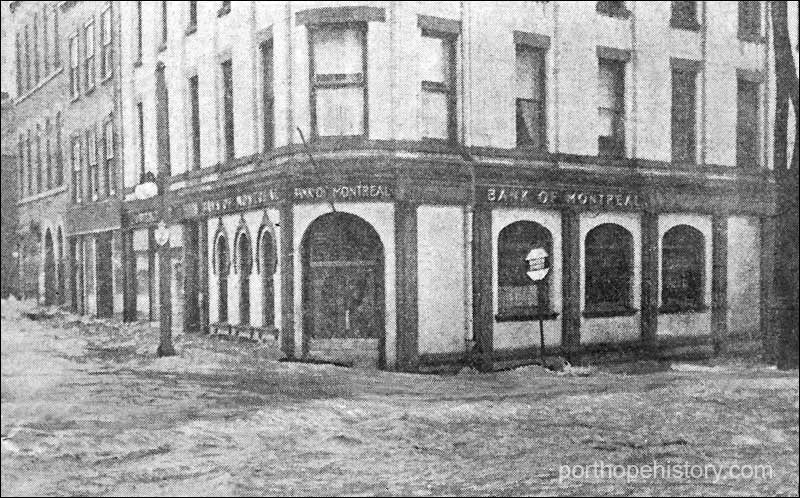
photo by Chris Woods, Toronto Telegram Jan 15, 1937
Employees of the Nicholson File Company were unable to get to work this morning, and although a few started at eight o'clock, work was temporarily stopped when the flood began to rise.
Workmen did what they could to alleviate the situation by raising the logs at the dam. A portion of the factory floors were flooded but damage is not expected to reach a large figure.
Corbett's Pond was filled to overflowing and water overflowed a section of the track near Boyce's Bridge. A portion of the roadbed north of the File Factory was inundated and two portions south of the bridge were swept away.
Railway traffic was demobilized and trains were despatched via the Belleville-Peterboro route. Highway buses were unable to keep to their regular route. Instead they used King Street, doubled back to the regular stop and then continued to the north of the town via Highway 28 and proceeded westerly to Welcome.
Water to the depth of two and three feet flowed down Mill and Queen Streets and many families were marooned. Mathewson's apartments, containing 12 families, was completely surrounded and persons were unable to get in or out. In the lower section of Walton Street, the flooded places included: British American Service Station, Stephenson's Bowling Academy, Mitchell's Flower Shop, Cancilla's Fruit Store, Sanders Hardware and A&P Grocery.
On Queen Street, the Bank of Montreal was flooded and a barricade was erected at the front door to keep off the force of the rushing tide.
A store, formerly occupied by George Gould, got its share of water and the front door was battered in.
The Port Hope Cafe was flooded, on the south side of Walton Street, as well as New Service Cleaners, Wells' Bakeshop and a Chinese laundry.
Most of the merchants were up at daylight and moved what stock they could to dry quarters. Others did not arrive in time and much stock was destroyed.
Carl Paeden, trucker, was unadvised of the rise in waters, and three of his delivery trucks on Cavan Street were submerged.
Pupils were able to attend school at the West Primary and the East Ward School, but classes at the Central School and the High School were temporarily suspended.
Around noon hour, a considerable recession in the water was noticed and later in the afternoon the streets became passable.
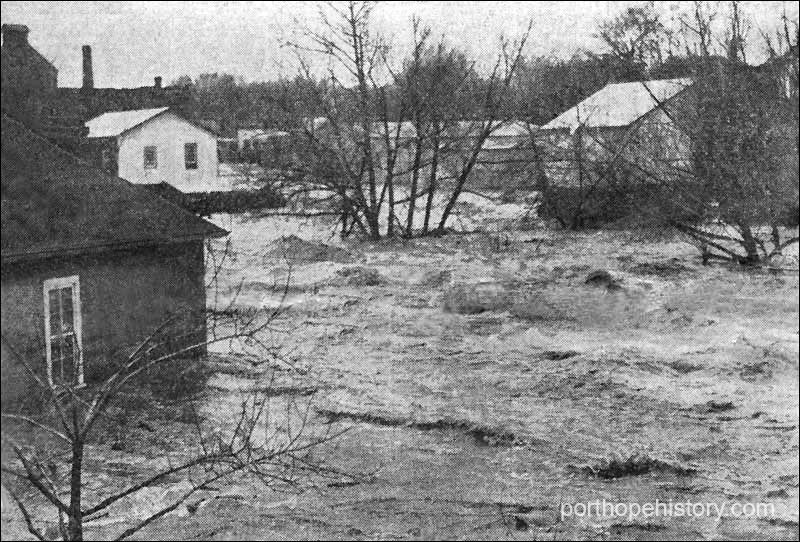
photo by Chris Woods, Toronto Telegram Jan 15, 1937
Rescued From Today's Flood
'Tommy' Uglow, Port Hope recluse and town character, had a narrow escape from drowning early this morning when the heavy flood hit Port Hope. As usual, 'Tommy' was sleeping with his clothes on in his shack at the rear of Messrs Jex and Smith's store on Ontario Street. He was unaware of the rapidly rising waters until notified by Gordon Jex and Arthur Smith. He was roused from his sleep and carried to safety.
Roy Croft, manager of the Maher Shoe Store, Port Hope, had a narrow escape from death by drowning, and after being carried a considerable distance down stream, was rescued. He was rushed to the Port Hope Hospital and was given attention by the nursing staff and Dr. R. McDerment. Early this afternoon, report stated that he was resting comfortably and was being assisted by stimulants and the generous application of hot blankets. He was suffering considerably from exposure and shock.
Accompanied by Ralph Snelgrove and Charles Snelgrove, Mr Croft was inspecting the damage done to the railway roadbed at the end of Beamish's Pond. About 25 feet of the embankment had been washed away and the trio attempted to cross by means of the suspended rails and ties. While crossing, one of the ties slipped from its moorings and Mr Croft was precipitated into the foaming torrent. He was carried about 125 feet downstream and due to the fact that he was wearing a heavy overcoat and the rushing current, he was unable to swim. For a time he was lost from view as he was swept down the stream but managed to grab a clump of willow trees. Arnold Coughlin, Ontario Street, was standing at the edge of the washout and saw Mr Croft fall into the water. Ernest Wilkins, Shuter Street, was standing on the tracks and saw Mr Croft desperately clinging to the clump of trees. Fully clothed, and with stout rope about his waist, he waded out into the water. The footing was bad but he courageously reached his objective. Mr Croft was carried to shore and then rushed to the hospital.
Interviewed at home, Mr Wilkins said the footing was pretty bad, but he managed to get out with the assistance of the rope. Mr Croft was in pretty bad shape when he was brought in and friends took him to the hospital.
Mr Croft told the Guide that the tie had slipped away and he plunged in. "Everything happened so quickly."